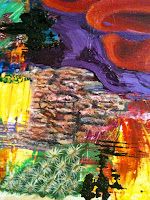
Real texture could be made of sand mixed with paint applied to the illustration board. This type of texture was easy because it used real substances. I used sand and small glass beads. This photo shows a simulated rock that has different sizes of sand incorporated into the paint.
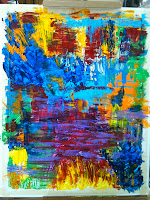
Invented texture was fairly easy because you could make up anything. For example, painting many tiny dots in white onto a red background or using impasto to build up a very thick area with interesting ridges. I used pure paint from the tubes and tried to avoid mixing colors too much. The impasto gave the background a lot of texture.
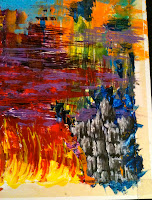
Simulated texture was the most difficult. For this type we had to copy a real texture such as tree bark and it had to look real. This type was the most time consuming because the colors had to be mixed correctly and tones and shades had to be put in the correct areas to create depth. This photo shows a small area of oak bark I painted.
My painting turned out very abstract and it is the first truly abstract piece I've done. I initially played with colors straight out of the tubes with a palette knife and covered the illustration board with interesting textures. I tried to keep complementary colors together to enhance some areas. Once I had my background I decided to incorporate the simulated and real textures within the invented ones to tie in all the areas together.
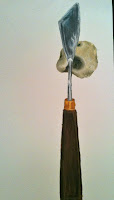 The last thing I made was the palette knife and rock which had to look real but were painted and cut out from a piece of illustration board and then glued on to the surface of the painting. I wanted my focal piece to look real so I even included a scoop of purple paint on the knife as though it had just been used.
The last thing I made was the palette knife and rock which had to look real but were painted and cut out from a piece of illustration board and then glued on to the surface of the painting. I wanted my focal piece to look real so I even included a scoop of purple paint on the knife as though it had just been used.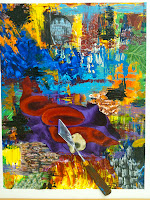
I learned that letting go and having fun with color can sometimes turn out better than if you had planned each detail. Using the abstract method and then combining some detail made this project a lot of fun and taught me that you can have both detail and abstract in the same work complementing each other to great effect.
these are pretty great, you have a good sense of color and are more abstract than you might think...I always knew you had it in you
ReplyDelete